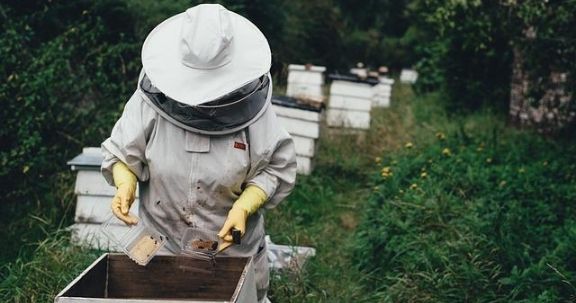If you’re here reading this, you must be considering keeping bees. How exciting! And if you live in the United States, it’s likely you’ve already seen Langstroth hives, either in fields, on tractor-trailers, or (sadly) on the news when CCD is discussed.
This hive may be the style you want to start with. It is a vertical frame hive. One of the nicest things about this hive is that there are many books and beekeepers who can help support you as you begin to learn about beekeeping.

If you are considering using this hive, you have to decide between ten frames or eight frames – this is the number of frames contained in each box or “hive body”. Ten frame hives have been the standard for a long time, but some backyard beekeepers are starting to run 8 frame hives. Eight-frame hive bodies are lighter to manipulate for the beekeeper and maybe more similar in diameter to a natural bee tree than a 10-frame hive.
You also have to decide about what size hive bodies and frames you want to use. Deep hive bodies are traditionally used on the bottom and contain brood (developing bees). Medium and shallow hive bodies are usually stacked on top to hold honey (because honey is much heavier than brood and so it’s easier on the beekeeper). Empty hive bodies are placed at the top of a Langstroth hive as it expands and the bees work their way up into it.
Foundation, a sheet of beeswax embossed with hexagonal honeycomb cell shapes, is often placed within the frames to guide bees into building a straight comb of a particular cell size. We know that wax foundation contains chemicals from the original wax used in manufacturing it. We also know chemical levels build up in all wax the longer it is in a hive.
Langstroth Pros:
- common, easy to find a mentor, especially for 10 frame hives
- 8 frames are lighter than 10, easier for the beekeeper
- medium hive bodies are lighter than deeps
- e.g. 8 frame medium full of honey = 56 lbs
- e.g. 10 frame medium full of honey = 70 lbs
- e.g. 10 frames deep full of honey = 100 lbs
- easier for the cluster of bees to move vertically up to food in the winter than across in horizontal hives
- having all equipment the same size (e.g. all 8 frame mediums or all 10 frame deeps) makes everything interchangeable
- easy to find equipment at bee supply stores
- the foundation keeps the comb neat and in line with the frames
- can go foundationless to reduce the chemical load in the hive
- can go foundationless to allow bees to build cells of any size = more natural
- frames are less fragile in an extractor than top bars that have no frame to support the comb
- can re-use frames of comb – reduces the bees’ workload so they don’t have to build as much wax comb & speeds up honey storage and population growth
- generally accepted that there is more honey production possible than with other hive styles
Langstroth Cons:
- more difficult to find a mentor for 8 frame hives as they are less common
- 10 frame hives may be wider than a natural bee tree – the bees may not use honey on the edges of the hive body in the winter
- maybe a little harder for the bees to move up within a hive of mediums in the winter because there are more gaps for them to cross as they climb vertically in a cluster
- need a fair amount of storage room for hive components when not in use
- inspections are more invasive than a Kenyan or Tanzanian top bar hive, letting light and temperature changes into the entire hive when opened
- foundation contains chemicals
- full sheets of foundation force bees to build a particular cell size = less natural
- if foundationless, bees can build comb across multiple frames attaching them together and making the hive un-inspectable
- reusing comb increases the chemical burden in the hive
- even a “light” 8 frame medium Langstroth hive body is heavy compared to lifting a single comb in a horizontal top bar hive
What I did:
Since I am not very strong and I do all the work on the hives myself, I’m running 8 frame mediums. I love having all the equipment all the same size, although having to store equipment is a pain. It’s great to have lots of beekeepers around me who can help me inspect the hives and suggest different management techniques. I alternate foundation and no foundation in my frames to allow my bees to do what they like some of the time but also reduce the chances of cross combing.